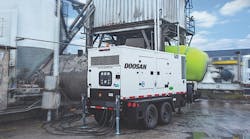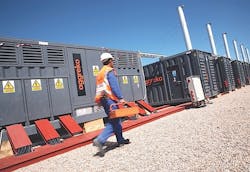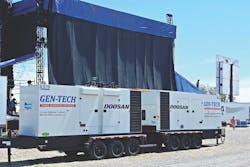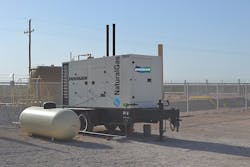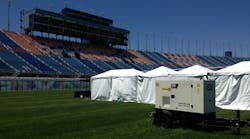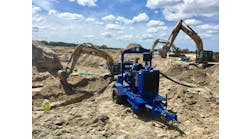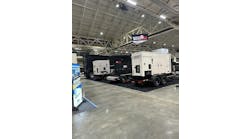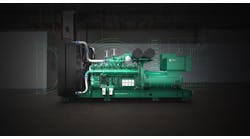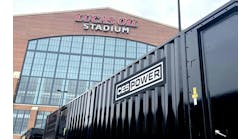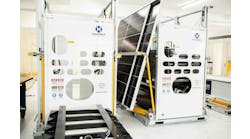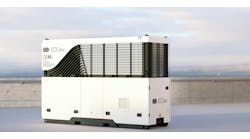It’s storm season. We can say it’s the season because hurricanes and tropical storms generally occur in the late summer and fall. However power outages occur year round. They can be caused by snow and ice storms in winter, fires, floods, earthquakes, grid issues, tornados, terrorist incidents and, summing it up in general terms, the unforeseen.
More than 8 million people lost power as a result of Hurricane Katrina, many for weeks and even months. While most storms are not as widespread and catastrophic, loss of power can cripple many businesses even if the loss is for a day or two.
For many businesses, the loss of power, especially for a prolonged period of time, can be extremely critical. Who will businesses call when power is cut off? Once they realize their local utility can’t help them right away, their next call is likely to be to an equipment rental company, more often than not to a power generation rental specialist. However, these callers probably are not the only ones that have lost power. If those companies don’t have a backup power plan already in place, it might be too late for them to quickly solve their power problem.
Rental companies that specialize in emergency power solutions don’t just suddenly spring into action when the storm hits. They work with customers on a year-round basis to make sure they have backup power procedures and plans in place long before the winds start blowing over the Caribbean or the Arctic air creates the conditions for an ice storm.
Once the storm hits, the customer knows exactly who to call and the rental company knows exactly what it’s going to do – who will deliver the generator to what address, what kind of generator, what other pieces of necessary equipment, where on the property to deliver the items, which electrical contractor will do the hook-up and dozens of other details that have been determined well in advance. As for the companies that never gave a thought to the possibility of having to power their businesses in an emergency and suddenly call a rental company in the middle of the night screaming “Help, I need a generator!” – they may get some help but it may take a while because there are a lot of people ahead of them on the priority list.
First the rental company needs to determine where to start.
“The rental rep must get the customer to walk through their most critical needs,” says Mark Hanson, vice president of sales, rental and distribution for Generac Mobile Products, Berlin, Wis. “For example: You look at an Internet company and if their servers go down without a plan, they’re out of business. If data is lost or corrupted, if the firewalls go down, they are at a major risk. And in that case, the cost of having a plan and a solution and a partner in place in advance is minimal compared to the exposure and risk of your entire business during that power outage.”
It usually starts with a site assessment or walk-through where the rental company can completely familiarize itself with the customer’s operation, power needs and the physical layout of its operation.
“During that visit we find out what their load is and what is the minimum we can bring over,” says Jason Flexen, Wagner Power rental manager for Wagner Power Systems. “In New Mexico, there are casinos and they say, ‘our first responsibility is security.’ So we go through the walk-through with them. And we figure out ‘Where do you want this, where are your connection boxes, where are your transformers’ so if they have an outage, we’re not trying to get hold of the facility guy at 3 in the morning. We can tell our driver, ‘Here’s where you need to drop it and this is who is going to hook it up.’ ”
The rental company needs to make a complete list including details such as where to park the generator, how many feet from the generator to the tie-in point, key phone numbers such as the electrical contractor and key staff, plans for who will provide fuel, ancillary products such as switches, cable, fuel tanks, and anything else that might be needed.
“We’ll do a turnkey solution except for making the initial tie-in into our customers’ facility,” says Chet Hastings, rental and used equipment manager, Blanchard Power Systems. “There’s too much liability there so we hire an electrical contractor to do that, or they can handle that themselves.”
“They need to have a very detailed agreement of roles and responsibilities for both parties,” adds Todd Howe, global generator product manager for Doosan Portable Power. “Certainly the rental company is going to have significant responsibility in terms of equipment, and also manpower and resources, because it’s the rental company’s responsibility in many cases to make sure the machine is deployed, and transported where it needs to be. They may be engaged in the connection of the generator to the site. They may be retained for other services such as fueling and maintenance. All of those things need to be detailed up front and make sure everybody understands what the others’ responsibility is. So clear expectations, clear outlining of responsibilities are key. And I would say internally the rental company must assess what its capabilities are and make sure it can live up to the requirements.”
Howe brings up the additional point that storms are not discriminatory, meaning the rental company itself is not immune to damages and power outages and must make sure it is prepared to keep its own systems running before it can help its customers.
Mike Madej, rental manager of Patten Power, Elmhurst, Ill., also emphasizes the importance of advance preparation.
“I’d get a call at 3 o’clock in the morning and it’s pouring rain and they have no power and they’re saying, ‘Mike, I need a generator, can you help me?’” he says. “And they don’t know where to find their electrical box. And I say, ‘You don’t understand, I can’t just send you a generator. Do you need a 20 kW or a 2,000 kW?’”
Madej also offers a site walk-through and then the preparation of an agreement covering all the details.
Rich Flynn, electric power business manager for Louisiana Cat, Reserve, La., has developed what Louisiana Cat calls PREP – Power Reliability Enhancement Program. “A local grocery store chain calls and said ‘I want to look at getting temporary power set up for the hurricane season,’ or just on an ongoing basis, so we go out and do a site survey,” Flynn says. “We take a look at their electrical loads, we size up their main panels, see if they have any temporary equipment in place. Many of them will have a transfer switch. We might recommend installing a transfer switch if they don’t have one, and temporary cables, it might be a temp box with camlock connections to tie into to minimize the set-up time for rental. We give them a booklet to develop what their needs are, how fast they want it set up, what they’re looking to do and what their budget is.”
Louisiana Cat focuses heavily on the industrial market where the power rental customers are already very savvy about the need for temporary power solutions and what the agreements entail.
Doosan’s Howe points out that it’s not just a question of installing power, but the quality and level of power that is important.
“Sometimes it’s not just natural disasters but other elements as well,” Howe says. “You can have snow and ice storms in winter, tornados and earthquakes, even wildfires can have an impact on the power grid and power availability, and so many more demands on the utility grid for not just available power but power quality as well. There are many processes and systems out there such as data centers or other sophisticated applications, like server farms for instance, where not just having power available is enough, they have to have good reliable power, with no brownouts or voltage surges or spikes of any kind. So any time there’s any potential for disturbance of the grid it doesn’t have to be a long-term outage, it can be a fairly short-duration event -- there are opportunities for rental generator sets to be in the mix as part of the solution to keeping those things running.”
Howe suggests that a rental company would require someone in the role of a project manager who would deal with internal issues as well as customer needs.
“So does your rental company have systems and processes in place to continue operation while it itself is in the process of evaluating and understanding the effects of the outage on their own end?” he says. “Can they deploy equipment, can they move trucks, do they have a contingency plan of what to do if roads are closed or are impacted by state-of-emergency curfews? So there are many many details there that need to be investigated. A resource like a project manager is going to be a very key asset for a rental company to investigate and evaluate all those potentials, and marry together all the right people across an organization, everything from fleet movers to your maintenance staff, to your risk management staff to make sure the organization can do what it has signed up for in supporting a customer network.”
A year-round proposition
The work of selling emergency plans doesn’t just begin when the storm clouds are gathering, but is, rather, a year-round proposition.
But the best time to sell a rental agreement, generator rental providers agree, is in the immediate aftermath of an outage.
“That’s when the awareness is highest and the willingness to make an investment because they’re living with whatever the impact was in that period of time,” says Howe. “And there’s a very exponential drop-off in interest over a very short period of time after an event happens. There’s always a spike for four to six months following an event and then it drops back off to normal business levels. Somebody that’s been affected by it in some way is going to be somebody that you have a very good opportunity to get in front of and make a presentation.
“As a rental company your goal is to sell the value of having a contract that guarantees a rental unit’s availability as opposed to that customer making the investment in a piece of capital equipment and making constant payments. So that’s where your value proposition as a rental company comes in, telling the customer ‘You don’t have to own a generator, you don’t have to make a permanent space for it, you don’t have to constantly make sure that thing is maintained and ready to run. But when there’s potential for an issue, I’ll be out there 24 hours before the event is even supposed to happen, and I’ll guarantee you uptime to this percentage and I’ll handle your fuel, I’ll handle your maintenance, and if it goes wrong I’ve got a backup machine coming for you.’ That’s where a rental provider’s value proposition is over a permanently installed genset.”
Nonetheless, the marketing of power agreements is a year-round task whether or not the need for it is top of mind. Rental companies need to help customers relate to the potential effects of a significant loss of power to mission-critical aspects of their business.
“Usually salesmen and myself will partner with the electrical contractor and we’ll visit businesses and together we’ll advertise what we have,” says Wagner’s Flexen. “We advertise our service department, we let them know the fleet we have, the range of units we have, what our capability is, we talk to them about 24 hour on call, both for service and rental needs.”
Doosan’s Howe says it goes back to the most basic principle, that of listening to the customer and understanding their needs, which are different than traditional construction machinery requirements.
“When a contractor needs to provide power to a worksite to build something or create something those needs are very different and in many cases much more simple than what a data center is going to require for guaranteeing that the power quality is there and that they have 100 percent uptime,” Howe says. “So the level of sophistication of what needs to be in the mix from a generator performance standpoint and also ancillary parts and pieces that need to go along with that, be it distribution gear or uninterruptable power supplies (UPS) systems, really start moving toward a much more sophisticated approach that starts to lend itself well to the more focused generator providers that are out there in our industry.”
As Howe says, the value proposition is far more of a partnership than the mere rental of equipment. Generac’s Hanson points out that as equipment becomes more complex with Tier 4, the rental company’s value is even greater.
“The larger rental companies have seen that as the tiers evolve, there is more complexity in managing the rental fleet,” he says. “Within these specialty groups, they are doing more than just the bare rental; they are doing more of a turnkey service, so they are helping customers size the projects instead of just providing generator rentals. They are providing distribution, panels, cabling, and actually in some cases doing the full setup of a system out on the project or events for the customer. So I would say the trend at least for the larger companies with specialty divisions is to provide a turnkey service platform as opposed to bare rental.”
And many smaller generator rental specialists already provide these services.
The slowdown in the oil and gas space is contributing to the growth of marketing of rental power at more local events such as fairs, sporting events, small local and regional shows. “You see a lot more external power being supplied as opposed to trying to use onsite power when you’re doing a larger event,” says Hanson. “They may not have the systems in place within the power banks at a hall, so they’re bringing in external power both for providing the power they need for the event as well as having a backup so they’re actually using the hard-wired power as backup to the temporary power. With older venues, where the systems don’t have the power requirements for the new light shows or the computer communication systems that are required with today’s technologies, the venues don’t have the capability so they’re bringing in rental power as the main power to drive the event and they’re using the power that was already existing as backup power should there be an issue with the rented power.”
The growth of generator telematics
Telematics systems, which have been widely adopted in earthmoving and aerial fleets, is currently surging in use in the power generation industry, fueled by providing power in remote locations such as oil-and-gas and mining applications, as well as generators typically being used in 24/7 situations.
While an excavator or skid-steer loader might work six or eight hours a day per day, the generator is more likely to be running 24/7. Telematics communicating fuel levels and fuel consumption data facilitates a task as basic as keeping the unit filled with fuel, allowing the rental company to calculate when they need to arrange to refill the machine, which translates to customer uptime and improved service.
“We first saw the emergence of this during the recent oil boom,” Howe says. “With the remoteness of where a lot of the production was happening and the fact that it was so difficult to get people out to some of those locations, that really started driving the need for machine communication back to the rental companies to make sure the generators were running and, if not, providing as much information as to why. We saw it there, but we see it also emerging in some of the more traditional rental applications. A lot of the big rental companies are making some pretty significant investments in IT infrastructure to incorporate machine data and telemetry into their rental management systems, so you’re seeing companies like United Rentals and Sunbelt Rentals, for instance, driving down internal costs of administration by having machines communicate directly into their rental systems, whether or not it’s closing out rentals or processing work orders, or calculating rental rate based on usage, they’re getting quite sophisticated with communication and integration.”
Howe adds that any time there’s potential for a fault, the sooner the rental company acquires the information, the quicker they can come up with a plan to either service or replace the unit, because of the premium placed on customer uptime. “That tells the customer to be confident that the rental company is on top of everything and is providing a higher level of service than they might be able to get elsewhere,” he notes.
Making machines quieter continues to be a trend in generator design and production. Generator manufacturers, like other OEMs, have put much of their focus in recent years on dealing with engine emissions standards, but have also continued to work on making generators quieter, as customers have continued to expect, in special event and other applications.
“We’re running quieter than our predecessors and we’re more fuel efficient than our predecessors, that’s certainly of benefit to a rental operator,” says Howe. “Customers with 24/7 usage want the most fuel efficient machines they can get. And they want easy-to-use machines because generators are a machine that maybe end users are a little afraid of because they don’t have the proper training or a good understanding of how it works. So simple-to-use, intuitive control systems and very clear indications where there’s a fault that needs attention, that’s something we put a lot of focus and attention to from our side.”
There are other trends as well. “With the advent from the last couple of tier changes Tier 3 to Interim Tier 4 and now to Final Tier 4, we’ve seen a reduction of diesel particulate matter by 90 percent and now with Tier 4, Nox levels are reduced 90 percent, so we need to control those engines and monitor them more closely,” says Ben Froland, product manager for power generation at Generac Mobile Products. “So the old analog gauge days are leaving us and we’re heading into the world of electronic controllers. Digital controllers with large screens on them are definitely a new trend for us.
“Paralleling is also becoming more popular. For the rental companies that gives them greater flexibility with their fleet so rather than purchasing a single large generator they have the option of purchasing a couple of smaller ones, renting them out on smaller generator jobs as available or combining the two to parallel on a larger job. It gives them flexibility to maximize the uptime for the customers; to give them the opportunity to service while one is up and the other one’s down.”
Hanson points out the additional trend of “containment systems and environmental protection to ensure that spills, leaks, and overflows of fluids don’t hit the ground,” as well as the ever-present focus on safety and sound attenuation.
Making it right
No matter what business opportunities, rental companies must be sure they keep generator sets load tested and in good running order, with the proper array of ancillary equipment and a full array of required parts to succeed in emergency situations. Making sure to have the right inventory for the needs of the market areas is equally important. And being prepared to support the machines in the field, as a rental company can do more harm than good by providing equipment that cannot be supported when needed most. A rental company must carefully monitor the commitments it makes as promising equipment and not being able to deliver in an emergency situation can seriously harm a rental company’s reputation.
Potential power outages can be great opportunities for rental companies to provide a service of inestimable value. But proper preparation is as critical as the power itself.
